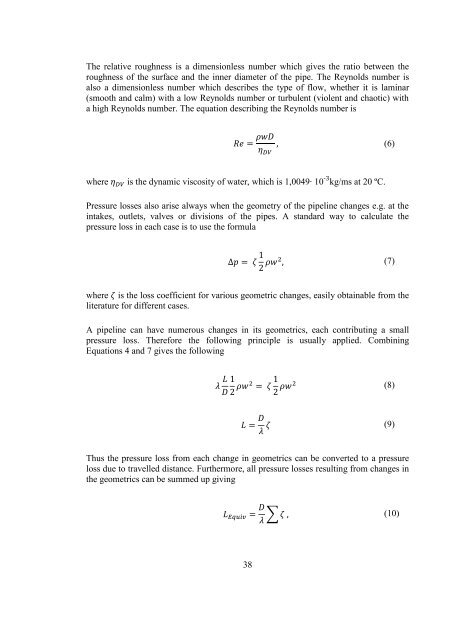A Feasibility Study - Aaltodoc - Aalto-yliopisto
A Feasibility Study - Aaltodoc - Aalto-yliopisto
A Feasibility Study - Aaltodoc - Aalto-yliopisto
You also want an ePaper? Increase the reach of your titles
YUMPU automatically turns print PDFs into web optimized ePapers that Google loves.
The relative roughness is a dimensionless number which gives the ratio between the<br />
roughness of the surface and the inner diameter of the pipe. The Reynolds number is<br />
also a dimensionless number which describes the type of flow, whether it is laminar<br />
(smooth and calm) with a low Reynolds number or turbulent (violent and chaotic) with<br />
a high Reynolds number. The equation describing the Reynolds number is<br />
where is the dynamic viscosity of water, which is 1,0049∙ 10 - kg/ms at 20 ºC.<br />
Pressure losses also arise always when the geometry of the pipeline changes e.g. at the<br />
intakes, outlets, valves or divisions of the pipes. A standard way to calculate the<br />
pressure loss in each case is to use the formula<br />
where is the loss coefficient for various geometric changes, easily obtainable from the<br />
literature for different cases.<br />
A pipeline can have numerous changes in its geometrics, each contributing a small<br />
pressure loss. Therefore the following principle is usually applied. Combining<br />
Equations 4 and 7 gives the following<br />
Thus the pressure loss from each change in geometrics can be converted to a pressure<br />
loss due to travelled distance. Furthermore, all pressure losses resulting from changes in<br />
the geometrics can be summed up giving<br />
38<br />
(6)<br />
(7)<br />
(8)<br />
(9)<br />
∑ (10)
















